Exchange Rate: Definition, Causes, Effects & Types
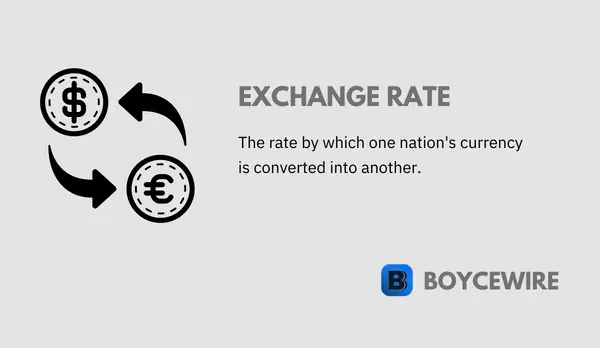
What is an Exchange Rate
An exchange rate is the value at which one currency can be converted into another. In other words, it is the rate or value at which one currency can purchase another currency.
For example, if the US dollar to Euro exchange rate is 1.5, it means we are able to purchase 1.5 Euro’s for one dollar. In this case, one US dollar is worth 1.5 Euros. The exchange rate is calculated using the currency purchased, divided by the currency sold. For instance, this would be 1.5 / 1 = 1.5.
The exchange rate is important because it identifies the value between two or more nations’ goods and services. It paves the way for international trade by sending a signal to the market the valuation of each good. For example, without an exchange rate, the US would not know how much $1 is worth to someone in China. Nor would the nation know how many goods or services it would be able to buy.
Key Points
- The exchange rate is the value by which two currencies can be traded for one another.
- Fluctuations in the exchange rate can be triggered by factors such as interest rates, economic performance, the trade deficit, or currency manipulation.
- There are three main types of exchange rate systems – fixed rate, floating, and managed.
The exchange rate is a useful economic tool. Countries with strong exchange rates often benefit from cheaper imports, but may find it more difficult to sell abroad. This is because international consumers require a far larger amount of currency to buy those goods. For example, if the US dollar is strong, it may mean that consumers from the UK will have to pay higher prices for goods from the US. However, it also means that the US consumers are able to convert their dollars to Great British Pounds and buy a large number of goods.
When the exchange rate fluctuates, and the US dollar weakens against the Great British Pound, the reverse becomes true. Those in the UK will then be able to afford more goods from the US, whilst US consumers will find British goods more expensive.
Causes of Exchange Rate Fluctuations
There are a number of factors that cause the exchange rate to fluctuate. Examples include – economic performance, size of the trade deficit, currency manipulation/monetary policy, and interest rates. Each plays an important part. Some more than others, but it can depend on a number of complex factors that may not be immediately obvious.

The main causes of exchange rate fluctuations are:
1. Currency Manipulation and Monetary Stimulus
It is difficult to tell the difference between currency manipulation and ‘monetary stimulus’. The action of ‘printing money’ is the same, but the motivation is different.
When a nation prints new money, its value declines because there is more of it. The increase in supply of the currency has to represent the same amount of goods and services in the economy. So unless the economy produces more goods to represent the new supply, it devalues the currency not only abroad, but also at home.
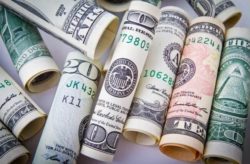
The main issue with identifying currency manipulation is whether that is a nations original intention. For example, the ECB printed around €2.6 trillion before its stimulus package in late 2019. Its aim was said to boost a failing economy.
However, since its peak against the dollar in late 2009, its value has crashed significantly. Starting at an exchange rate of €0.67 to the dollar, it fell to €0.91 by 2019. With the said, the monetary stimulus is but a part of the cause. It is a contributory factor, but not necessarily the most important one. In this case, we can assume that the weakening of the exchange rate was not manipulative, but it still has the same effect whether the intention was there or not.
2. Economic Performance
An economy that registers negative or even slow growth may face some level of capital flight. For example, investors that see a struggling economy are often quick to move their money. This is because when the economy is struggling, the returns on investment tend to be low. So investors move it to somewhere where returns are higher. In turn, the exchange rate weakens as there is less demand for that currency.
In the same fashion, an economy that is booming is also attractive to investors. For instance, the UK experienced comparatively strong economic growth between 2013 and 2015 – significantly outperforming the Eurozone. This contributed to the value of the Great British Pound increasing from an exchange rate of around 1.17 to the Euro in 2013, to 1.40 to the Euro in 2015.
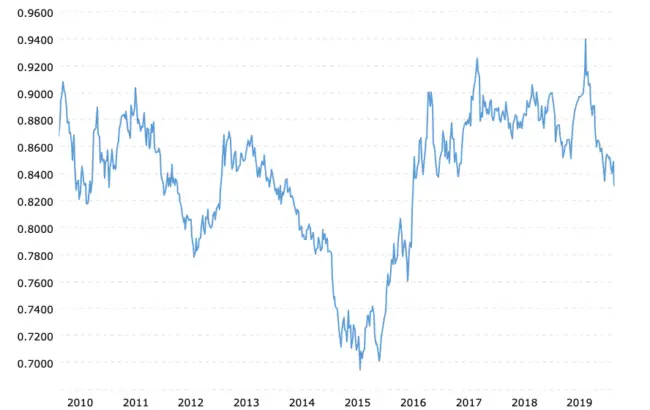
Source: Macrotrends
3. Trade Deficits
When a nation has a trade deficit, it buys more from abroad than it sells. In other words, it is sending money abroad to buy international goods, but foreign nations are not buying as much coming the other way.

This represents a cash outflow from the country, which reduces the demand for its currency. Subsequently, this decline in demand results in a weakening of the exchange rate.
4. Interest Rates
The interest rate can play a big part in exchange rate fluctuations. Investors will always seek out the best return on investment. As a result, those countries that offer relative safety and a higher interest will attract greater levels of investment.
At the same time, relative safety is also important – as investors want to maximise their return whilst reducing risk. For example, nations such as the UK, the US, and Japan offer safe places to invest, whilst the EU is also a relatively investor friendly area. By investing in those nations and regions, the investor can be relatively comfortable that their investment is safe.
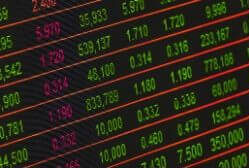
When comparative interest rates go up, it provides a greater return on investment – meaning country A now offers an extra 5 percent return on investment. However, interest rates only play a small role in the grand scheme of things. Political factors and economic growth, are more effective at causing investment shifts.
So when considering interest rates as a factor, we must consider it in line with others. For instance, the Euro strengthened significantly in 2017 and 2018. Yet its base rate was set at 0 percent. At the same time, the US increased its rate from 0.5 percent to 2.5 percent.
The Euro gained roughly 17 percent as a result despite comparative interest rates falling. The reason was that the Eurozone experienced rapid economic expansion, whilst the US was experiencing political tension with North Korea and China. So whilst interest rates can play a part, other factors can be more influential in causing the exchange rate to fluctuate.
Effects of Exchange Rate Fluctuations
The main effects of exchange rate fluctuations are:
1. The Economy
When the exchange rate weakens, the domestic currency cannot buy as many goods from abroad, which makes imports more expensive, and domestic goods cheaper.
Under such circumstances, consumers may start switching to cheaper domestic options, so fewer goods are imported from abroad. This may provide a boost to domestic firms as exports are cheaper for international consumers. The economy benefits from an increase in demand from abroad as its goods are now cheaper. Exporters sell more goods and will need more employees to fulfil that demand, thereby creating domestic employment and a boost to the overall economy.
At the same time, a strengthening exchange rate and currency could do the opposite. A stronger domestic currency makes international goods cheaper, which makes imports more appealing and can damage domestic firms. Yet there is also a benefit to cheaper imports. For example, having cheaper goods come in from abroad gives consumers more income to spend on other goods within the economy.
2. Consumers
When the exchange rate depreciates, imports become more expensive. So imported goods such as bananas, motor vehicles, and oil/gas increase in price – meaning consumers are paying more for the same number of goods.
By contrast, a strengthening currency makes for cheaper imported goods. However, consumers are also workers, so a strengthening currency may also impact jobs. As exports become more expensive to the international community, demand tends to decline, which could have a detrimental impact on industries that rely heavily on exports.
3. Business
Exchange rate fluctuations can cause businesses massive headaches – particularly small and inexperienced firms.
When Business A in the US buys from Business B in China, Business B has two options. It can either demand local currency, and risk the potential loss of a client, or, accept US dollars. Generally speaking, most companies accept the buyers local currency rather than risk losing a sale. After all, it is preferable to the client and poses less risk to them. However, the risk is then burdened by the producer of the good.
Depending on the contract, the producer may wait 30 days for payment. As they generally get paid in a foreign currency, it is possible for there to be some movements in the exchange rate. This has the potential to cause some minor losses that could pile up if the local currency is in constant decline.
4. Foreign Direct Investment (FDI)
When the exchange rate weakens, it makes the domestic currency cheaper to other nations. So a fluctuation that weakens the currency makes it cheaper for other nations to invest.
For instance, if the US dollar weakens against the Chinese Yuan, it means US consumers will receive fewer goods in exchange for their money. This is because more US dollars are needed to buy the same number of Yuans.
As a result, an investor from China will find it cheaper to invest in the US.
If we look at the chart below, it looks at the Euro to US Dollar exchange rate. As we can see, the Euro strengthens significantly against the dollar between 2002 and 2008. At the same time, the US was also losing value against other currencies. What happened was that Foreign Direct Investment became cheaper for international companies, and we can see this have a direct positive effect on investment.
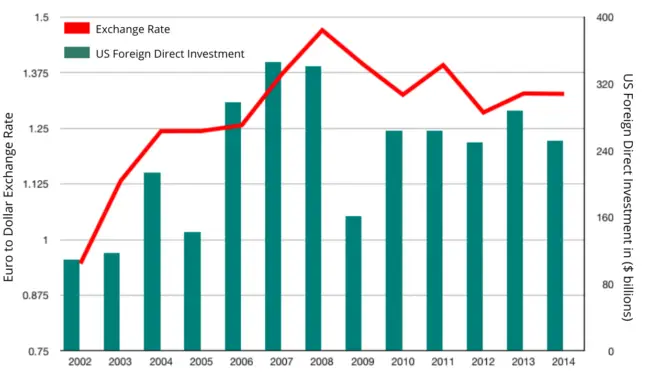
Sources: Euro-Dollar Exchange Rate : US Foreign Direct Investment
With that said, the exchange rate is not the only factor in FDI, but one contributory factor. So although the exchange rate can influence it, it is not necessarily the sole cause.
Types of Exchange Rate Systems
1. Flexible or Floating Rate
The floating exchange rate is a relatively new system that started to gain traction in 1973 after the collapse of the Bretton Wood Agreement. It simply allows the market to decide the value of the currency through the supply and demand mechanism. In other words, the value of a currency in relation to another can fluctuate.
Reactive
As we have seen previously, there are a number of variables that can influence the exchange rate. By employing a floating rate, it allows other currencies to react. For instance, one nation may be printing trillions in its local currency.
In turn, its value on the foreign exchange market would decline, whilst others strengthen. By contrast, a fixed rate would keep the currency at the same rate. So one nation could print trillions and exchange it for another currency at the same rate.
For example, both Nation A and Nation B have 1 trillion in currency, with a fixed exchange rate of 1. However, Nation A prints another 500 million in currency. So Nation A has a total of 1.5 trillion compared to Nation B’s 1 trillion.
However, because 500 million has been printed, inflation occurs and it can buy fewer products domestically. In turn the 500 million from Nation A can be traded for 500 million from Nation B. However, the purchasing power it has in Nation A is far less than Nation B. What a floating currency does is reduce the impact that such monetary stimulus would have.
Stabilising Effect
A floating exchange rate allows countries to weather shocks more effectively. This is because when a nation’s economy and aggregate demand declines, so too does the demand for its currency. In turn, a weakening currency makes the nation more competitive in the international market.
Therefore the demand lost at home can be complemented by increased demand from abroad. As a result, this helps soften the economic blow and boost domestic employment.
2. Fixed-Rate
A fixed exchange rate is where one currency is ‘pegged’ to another currency or a commodity. In other words, Currency A will be fixed at a rate of 2.5 to Currency B. So no matter whether interest rates change, economic conditions change, or there is a trade deficit, that rate will remain the same.
If we look back to 1944, the US tied the dollar to gold under the Bretton Woods agreement. From 1944 until the agreement ended in 1971, the rate was held at $35 to an ounce of gold.
This provided the dollar with great strength as the currency had an underlying value. So anyone with a dollar knew they could obtain gold with it. However, as the number of dollars in circulation increased, the supply of gold did not keep up.
What happened as a result was there were many more US dollars than gold that it could be purchased for. In other words, the US did not have enough gold to satisfy the promised exchange rate of $35 to one ounce of gold.
3. Managed Rate
A managed exchange rate is a kind of hybrid between a floating exchange and a fixed one. It allows the currency to float on the market, however, it is subject to certain regulations. Some nations may look to implement strict limits. For instance, the exchange rate between the US dollar and the Chinese Yuan may be set between 6 to 7.
There are also cases where the Central Bank deliberately intervenes in the market. For instance, the US dollar may be rising in value against the Indian Rupee. To counteract this, the Central Bank of India may sell significant amounts of reserve dollars to reduce its demand.
At the same time, a strengthening Rupee may be counteracted by the purchasing of US dollars instead. This would supply the market with Rupees, thereby decreasing its comparative value.
A managed exchange rate is one in which a currency is left to float within a lower and upper level, in which the central bank can intervene to “decide” the value of the currency. Here, there is a lot more intervention than at a flexible rate.
Related Topics
FAQs on Exchange Rate
An exchange rate is the value by which two currencies are swapped with each other. In other words, it is the rate or value at which one currency can purchase another currency.
The exchange rate is used to swap one currency for another. It is also a useful indicator to determine how well an economy is doing. For instance, a strong currency is generally associated with a strong and growing economy, whilst a weak currency is associated with a weak economic outlook.
There are four main contributory factors that affect the exchange rate. They are:
1. Currency Manipulation/Monetary Policy
2. Economic Growth
3. Interest Rates
4. Trade Deficit
About Paul
Paul Boyce is an economics editor with over 10 years experience in the industry. Currently working as a consultant within the financial services sector, Paul is the CEO and chief editor of BoyceWire. He has written publications for FEE, the Mises Institute, and many others.

Further Reading
 Aggregate Demand: Definition, Components & Examples - Aggregate demand refers to all the goods produced and brought within the economy. Economists calculate this using values at a…
Aggregate Demand: Definition, Components & Examples - Aggregate demand refers to all the goods produced and brought within the economy. Economists calculate this using values at a…  Coefficient of Determination - The coefficient of determination is a statistical measure that indicates the proportion of the variance in a dependent variable that…
Coefficient of Determination - The coefficient of determination is a statistical measure that indicates the proportion of the variance in a dependent variable that…  Credit Default Swap - A credit default swap (CDS) is a financial derivative that offers protection against the risk of default on a debt…
Credit Default Swap - A credit default swap (CDS) is a financial derivative that offers protection against the risk of default on a debt… 